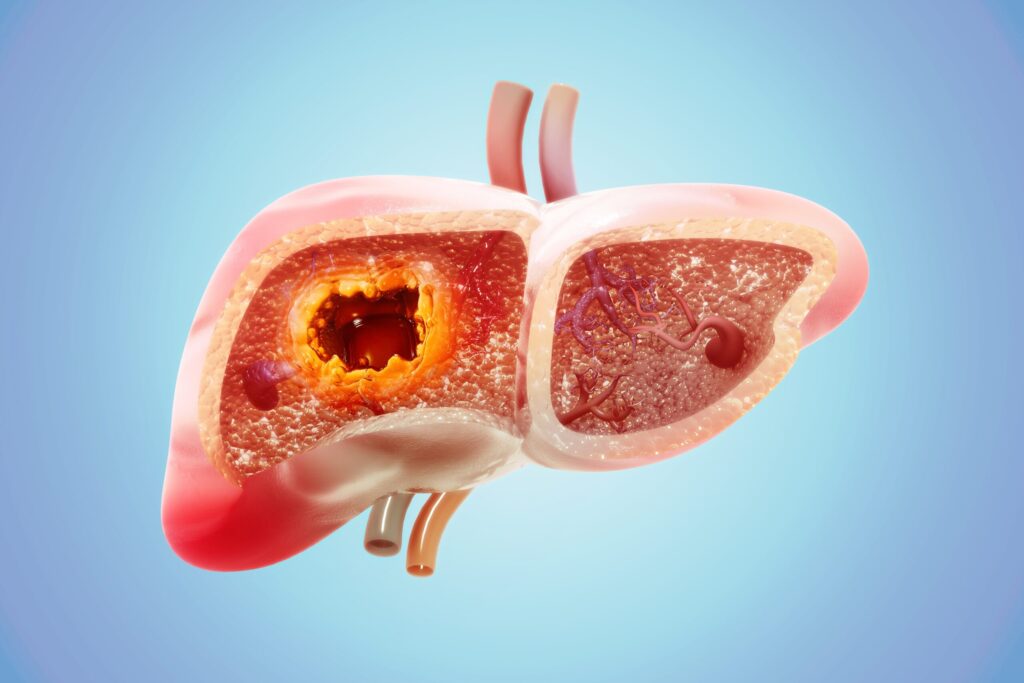A new international study led by Mayo Clinic researchers has identified a genetic factor that may explain why some patients with colorectal cancer that has spread to the liver experience more severe liver damage after chemotherapy. In their study, published in The Lancet eBioMedicine, the team showed the a single nucleotide polymorphism (SNP) in the PNPLA3 gene is associated with a heightened risk of chemotherapy-associated liver injury (CALI) in patients receiving neoadjuvant chemotherapy for colorectal cancer liver metastases (CRLM).
“This is the first study to clearly show that a genetic predisposition plays a significant role in how the liver tolerates chemotherapy,” said senior author Patrick Starlinger, MD, PhD, a hepatobiliary and pancreas surgeon at Mayo Clinic Comprehensive Cancer Center.
This specific mutation in the rs738409 variant, also known as PNPLA3 I148M, which has been linked to metabolic liver diseases, alters lipid metabolism in the liver and contributes to the development of steatohepatitis.
For their research the investigators conducted a retrospective analysis of 551 patients who underwent neoadjuvant chemotherapy followed by liver resection for CRLM. Of these patients, 149 had histological samples that had been genotyped to assess the presence of SNPs already known to be associated with chronic liver disease. Liver health during the chemotherapy was assessed using the combined APRI + ALBI score, a non-invasive composite marker that is used to assess liver function and liver injury from chemotherapy.
“Within this retrospective multi-center analysis we were able to document that CALI development significantly varies between patients undergoing neoadjuvant chemotherapy for CRLM. Assessing a panel of liver disease associated SNPs, we were able to document that the PNPLA3 I148M variant was associated with an increased susceptibility to CALI in these patients,” the researchers wrote.
Patients with the PNPLA3 I148M mutation, especially those with the homozygous genotype, had much higher APRI + ALBI scores during chemotherapy, which indicated their had been some form of liver injury. All patients who were homozygous for this mutation were classified as high-risk based on their post-chemotherapy APRI + ALBI scores. This subset of patients demonstrated significantly worse overall survival (OS) following liver surgery.
“Patients with APRI + ALBI scores (≥−2.46), associated with the development of CALI, showed decreased OS after hepatectomy,” the researchers wrote. “CALI and its effects on liver function not only impact immediate postoperative outcomes but also significantly affect OS in CRLM patients undergoing liver resection.”
The researchers said that that the PNPLA3 I148M variant may begin to explain the variance in outcomes reported across global studies of neoadjuvant chemotherapy in CRLM, noting that the prevalence of the I148M variant varies significantly by population. For instance, more than 41% of the Japanese population and more than 71% of those of Peruvian descent carry at least one copy of the mutation, while the rate for some European populations is less than 10%.
“These findings offer us insight into how we can adjust treatment strategies to best manage the care for patients diagnosed with colorectal liver metastases, while potentially avoiding a negative side effect of chemotherapy,” said Starlinger. “Chemotherapy may still be an appropriate treatment option, and with this information, we can personalize treatment for each patient—for example, tailoring chemotherapy or allowing more time for the liver to recover before surgery.”
The researchers noted that patients with the PNPLA3 I148M mutation, and especially those with the homozygous form, could benefit from extended recovery periods after neoadjuvant chemotherapy before surgery. Since liver function has been shown to partially recover during breaks from chemotherapy, a patient’s APRI + ALBI scores can improve within weeks, they could be used to guide surgical timing.
While the study offers a potential explanation for neoadjuvant chemotherapy-related liver injury, it has limitations. The number of patients with genotyping data wasn’t large enough to provide for broad statistical generalization so, larger prospective studies will be needed to validate the findings, as well as to look for other genetic contributors to CALI.

